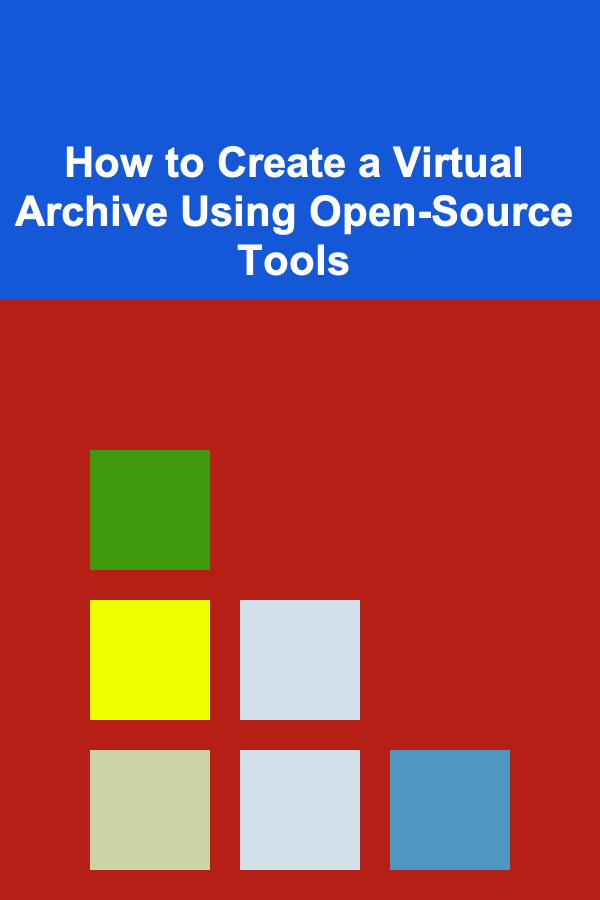
How to Create a Virtual Archive Using Open-Source Tools
ebook include PDF & Audio bundle (Micro Guide)
$12.99$6.99
Limited Time Offer! Order within the next:

Creating a virtual archive is a powerful way to organize, store, and retrieve vast amounts of data, all within a digital environment. Whether you're looking to store historical documents, academic resources, multimedia collections, or a diverse range of other data, building your own archive using open-source tools offers an affordable and customizable solution. Open-source tools provide flexibility, transparency, and often a large community of users who can contribute to the development and improvement of the software.
In this article, we will walk through the steps involved in creating a virtual archive using open-source tools, from planning the archive structure to selecting the right software, implementing data storage and access methods, and ensuring long-term preservation.
Understanding the Need for a Virtual Archive
Before diving into the technical aspects of building a virtual archive, it's important to understand what a virtual archive is and why you might want to create one. A virtual archive refers to a digital repository designed to store data in an organized manner, typically with the ability to search, retrieve, and manage the stored content efficiently. Virtual archives are often used in the following scenarios:
- Digitizing historical records or physical documents: This allows easy access to valuable information without the physical limitations.
- Creating a multimedia library: For storing videos, audio files, images, and documents in an easily searchable format.
- Collaboration and research purposes: Archives that enable multiple users to contribute, edit, or query data.
With the right tools and architecture, you can build a flexible, robust, and scalable system that serves these needs effectively.
Planning Your Archive Structure
The first step in creating a virtual archive is to plan its structure. The design of your archive will depend on the type of data you intend to store, the volume of content, and how you want to access and organize it. Here are some key considerations when planning your archive:
Types of Content to Archive
- Textual Data: Documents, reports, books, articles, etc.
- Multimedia: Images, videos, audio recordings, etc.
- Metadata: Information describing the contents of the archive, such as file names, authors, publication dates, keywords, etc.
Hierarchical Organization
Decide how you want to categorize the content within your archive. You could use a flat structure or a more hierarchical structure with categories, subcategories, and metadata tags. Some ideas to consider:
- Folder Structure: A simple folder-based organization where each file is stored in a specific directory based on its content type or category.
- Taxonomy and Metadata: A metadata-driven approach that tags content with keywords, categories, and other attributes for easy search and retrieval.
Storage and Access Requirements
- Storage Scalability: How much data do you expect to store in the future, and how will it scale? Open-source tools should be chosen based on their ability to handle large amounts of data.
- Access Control: Will your archive be public or private? You may need to set user permissions to allow or restrict access to specific files or categories.
- Search Capabilities: Ensure the software chosen has strong search capabilities, allowing users to find specific documents or files quickly.
Long-term Preservation
Consider the long-term preservation of your data. Virtual archives should be designed with redundancy and reliability in mind, to prevent data loss over time. This could involve backups, storage replication, or integration with external cloud storage.
Selecting Open-Source Tools for the Archive
Several open-source tools can help you build a virtual archive, each with different features tailored to various use cases. Below, we will explore some of the most commonly used open-source tools for creating virtual archives.
3.1 Archival Management Software
These tools are specifically designed to help with the organization, storage, and management of archives.
- Archivematica: A comprehensive digital preservation system that integrates with other tools to manage data storage and retrieval. It supports standards like PREMIS and Dublin Core for metadata, making it a strong choice for long-term preservation.
- DSpace: Primarily used by academic institutions, DSpace is an open-source repository software that supports the storage and access of scholarly content. It supports workflows for data ingestion, metadata management, and search functionality.
- Omeka: Ideal for museums, libraries, and archives, Omeka allows users to create digital collections with rich metadata support. It also features a flexible plugin system that can be used to extend its functionality.
- Greenstone: A digital library software designed for managing multimedia content. It allows users to create their own digital library, complete with searchable databases, digital documents, and multimedia.
3.2 File Storage and Database Solutions
For scalable and efficient storage of your archive content, you will need a system to store and retrieve large amounts of data.
- Nextcloud: A self-hosted cloud storage solution that allows you to store files securely. Nextcloud also provides collaborative features like file sharing and versioning, which can be useful for working on archive content in teams.
- Ceph: An open-source storage system designed to provide highly scalable object storage. Ceph is ideal for building a robust, fault-tolerant system to manage large volumes of archived content across multiple servers.
- MySQL or PostgreSQL: These relational databases are often used to store metadata related to your archive, such as descriptions, author information, and tags. They support full-text search, which makes retrieving information from large datasets much easier.
3.3 Search and Retrieval Tools
Search capabilities are vital for any virtual archive. Without robust search features, users may struggle to find specific content.
- Elasticsearch: A powerful open-source search engine that allows for full-text search and analytics. It is highly scalable, and its integration with tools like Logstash and Kibana (the ELK stack) allows for more sophisticated data processing and visualization.
- Apache Solr: Another popular open-source search platform that offers faceted search, full-text indexing, and real-time indexing. It can be used to index metadata and content within your archive, making it easier for users to find information.
3.4 Web Interface for User Access
If you want to make your virtual archive accessible via a web interface, you'll need a tool that can present your data to users in a user-friendly way.
- WordPress: While primarily known as a blogging platform, WordPress can be extended with plugins to act as a content management system (CMS) for archives. With the right plugins, WordPress can support metadata management, file organization, and user access controls.
- Drupal: A flexible CMS that can be used to create a customized web portal for your virtual archive. It has powerful taxonomy features that allow you to organize and tag content easily.
- Koha: An open-source integrated library system (ILS) that can be used to manage and catalog resources in an archive. It provides features such as metadata entry, item categorization, and search.
Implementing the Archive
Now that you have a clear plan and have selected the tools for your virtual archive, it's time to implement the system. Below are the key steps involved in this process.
4.1 Data Preparation and Ingestion
The first step in populating your archive is to prepare the data for ingestion. Depending on the type of data you're storing, this process will vary:
- Digitizing Physical Documents: If you're archiving physical documents, you will need a scanner or OCR (optical character recognition) software to digitize and index the content. Tools like Tesseract (an open-source OCR engine) can help convert scanned documents into machine-readable text.
- Metadata Creation: For each piece of content, create metadata that describes the file. This metadata can include fields such as title, author, description, keywords, and categories. Tools like OpenRefine can assist in cleaning and organizing metadata.
- File Organization: Depending on your chosen structure, upload the data into your storage system, organizing it into folders or tagging it according to its metadata.
4.2 Setting Up the Search Index
Once your data is ingested, the next step is to set up the search index. This will enable users to quickly find content within the archive. With tools like Elasticsearch or Solr, you can index your content and metadata, creating a robust search system. Be sure to configure the search engine to prioritize important metadata fields like title and tags, and include full-text search capabilities if necessary.
4.3 Designing the User Interface
If you're building a public-facing archive, the next step is to design the web interface. Depending on the CMS or platform you selected, you can design the user interface to display content in an organized and visually appealing way. Consider including the following features:
- Search Bar: Allow users to search for specific terms, tags, or categories.
- Filters: Provide filters that allow users to narrow down search results based on date, category, or other criteria.
- Preview and Access: Provide an easy-to-use interface for users to preview and access archived content.
4.4 Implementing Access Control
Depending on the sensitivity of the content, you may need to implement access control mechanisms to restrict who can view or contribute to the archive. This can be done through:
- Role-Based Access Control (RBAC): Allow different types of users (admins, editors, visitors) different levels of access.
- Authentication: Use authentication systems like OAuth or LDAP to control who can log in and access the archive.
4.5 Backup and Redundancy
To ensure the long-term preservation of your archive, implement regular backups. Set up automated backups of both the content and metadata, storing them in multiple locations for redundancy.
Maintaining and Updating the Archive
After your virtual archive is up and running, ongoing maintenance is crucial. Regular updates will ensure the archive stays organized, secure, and relevant. Here are some best practices for maintaining your archive:
- Regular Content Updates: As new materials are added, update the archive's structure, metadata, and search functionality accordingly.
- Monitor for Security Threats: Ensure that the archive remains secure by monitoring access logs, applying security patches, and protecting the system from unauthorized access.
- Long-Term Preservation: Over time, data formats may become obsolete. Plan for migration to newer formats and ensure that the archive remains accessible and usable in the future.
Conclusion
Creating a virtual archive using open-source tools offers a cost-effective, flexible, and customizable way to organize and preserve your digital content. By carefully selecting the right tools, designing a robust architecture, and implementing strong data management and preservation strategies, you can build an archive that serves your needs for years to come. Open-source tools provide the flexibility to adapt the system to your specific requirements, making it easier to scale as your archive grows. Whether you're archiving historical records, multimedia content, or scholarly materials, the process outlined here will help you build a sustainable and efficient virtual archive.
Reading More From Our Other Websites
- [Star Gazing Tip 101] Star-Gazing Essentials: Gear, Apps, and Tips for Clear Skies
- [Organization Tip 101] How to Create a Personalized Cleaning Supplies Caddy
- [Home Soundproofing 101] How to Manage Indoor Noise Pollution with Home Soundproofing
- [Home Lighting 101] How to Use Lighting to Improve Your Home's Feng Shui
- [Organization Tip 101] How to Plan a Home Renovation Project: Step-by-Step Guide
- [Personal Care Tips 101] How to Build a Sustainable Self-Care for Mental Health Practice That Works for You
- [Biking 101] Top 5 Bike Tools for Easy On-the-Go Repairs
- [Small Business 101] How an E-commerce Platform for Small Business Can Boost Your Online Sales
- [Simple Life Tip 101] Best Strategies for Reducing Screen Time While Staying Connected
- [Organization Tip 101] How to Safely Strip Paint and Varnish from Your Furniture

How to Build Custom Shelving for Better Home Organization
Read More
How to Clean Your Home After a Home Improvement Project
Read More
How to Monitor Your Credit Score and Improve It
Read More
How to Protect Your Antiques from Damage and Deterioration
Read More
How to Refresh Your Home Office with Seasonal Decor
Read More
How to Get a Credit Card with Bad Credit
Read MoreOther Products

How to Build Custom Shelving for Better Home Organization
Read More
How to Clean Your Home After a Home Improvement Project
Read More
How to Monitor Your Credit Score and Improve It
Read More
How to Protect Your Antiques from Damage and Deterioration
Read More
How to Refresh Your Home Office with Seasonal Decor
Read More